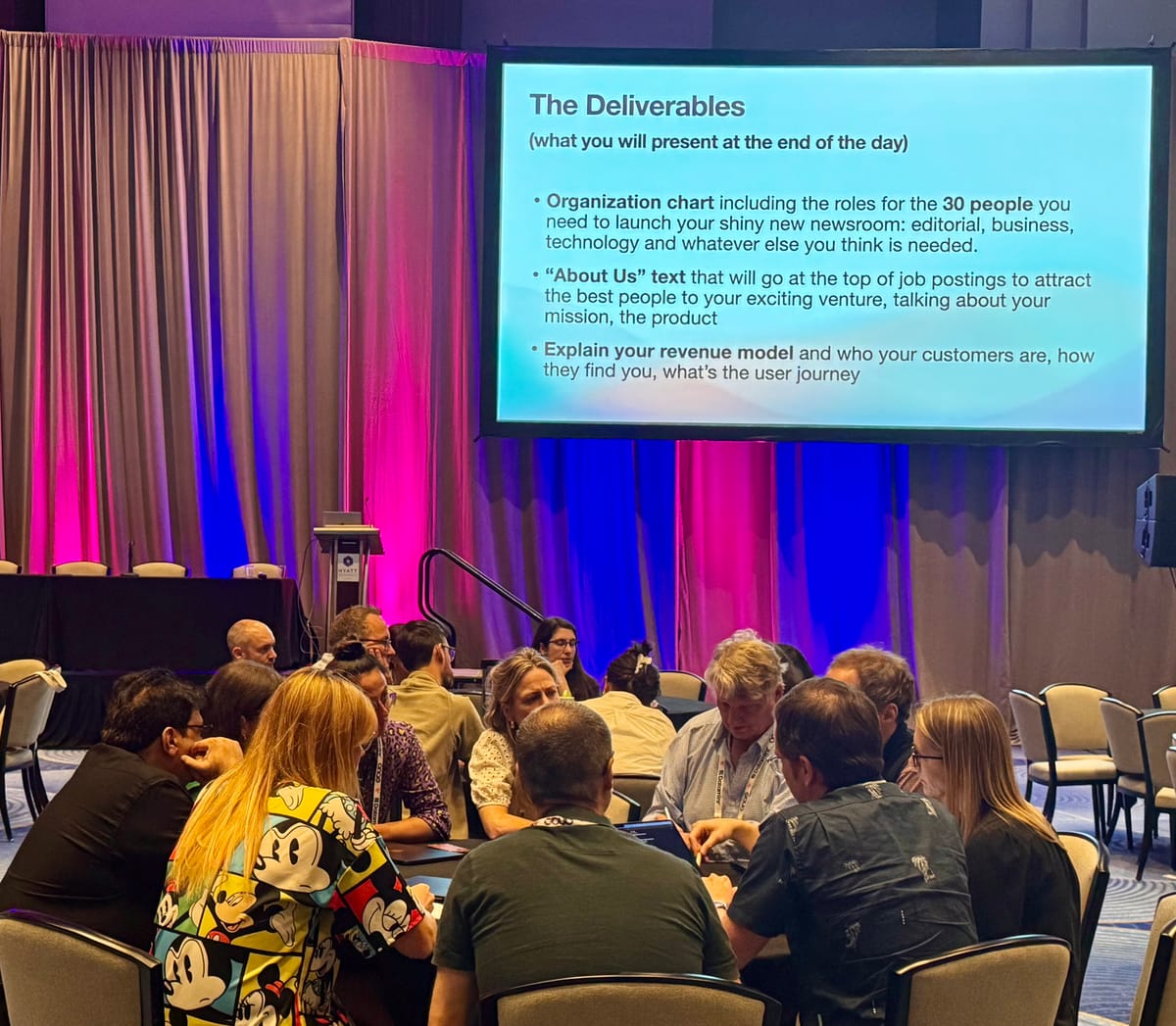Envisioning the Future of News: Launching the AI-Driven Journalism Startups of 2030
How journalists imagined the newsroom of 2030 at the Hacks/Hackers AI workshop at ONA 2024.

Hacks/Hackers brought a time machine to the Online News Association 2024 conference in Atlanta, transporting a room of newsroom leaders to the year 2030. By traveling five years into the near future – even if only as part of the ‘playful’ process of ideation – workshop participants envisioned how news startups launched from the start to embrace the technological advancements of artificial intelligence might survive and even thrive in an era of change.
Over the full-day workshop, more than 50 journalists and executives from news organizations around the world developed plans for news and information startups that would launch in 2030 — a future that’s close enough to see where likely trends are headed, and also not so far away to be the realm of science fiction. The group was asked to develop organizational charts, company descriptions and a revenue model for their startups. Constraints included a limit of 30 people on their founding team, plus a vision of how to achieve sustainable revenue.

A few assumptions about the newsroom of 2030…
To inspire attendees and get them in the right frame of mind, we outlined a set of assumptions for the technological advancements that are likely to be the state of play just over five years from now:
Hyper-personalized, AI-curated content
- AI algorithms will be advanced enough to create highly tailored news feeds for each user
- Content will be dynamically adjusted based on real-time user behavior and preference
Hyper-personalized, AI-curated content Immersive and interactive news experiences
- Virtual and augmented reality technologies will be mainstream for news consumption.
- News stories will often include interactive elements, allowing users to explore data, locations and multiple perspectives.
AI-assisted reporting and content creation
- AI tools will be integral to the news gathering and production process in all formats.
- Automated fact-checking and advanced data analysis will be standard.
- Natural language processing will enable instant translation and localization of content.
Decentralized, transparent information and network ecosystems
- Blockchain or similar technologies will be used to ensure transparency in sourcing and editing processes.
- Collaborative fact-checking and open-source journalism models will be more prevalent.
To kick things off, workshop participants volunteered to act as CEOs of future news startups. After some quick brainstorming, these would-be startup CEOs pitched their ideas to attract their founding executive teams, eventually dividing into six groups that spent the rest of the day hashing out launch plans.

Using AI in journalism to connect users with news
Several key themes emerged, including the integration of AI, journalism, emotional well-being, and audience engagement, as well as a major focus on personalized news experiences.
One project, Verbinden, meaning “connect” in German, would engage users with a news organization’s archive through personalized avatars. Another group’s proposed venture, VibeShift, would use biometric signals to match stories to users' emotional states. These innovations would enhance engagement by addressing both user preferences and emotional well-being, aiming to foster a healthier relationship between audiences and news.
Enhancing accuracy and engagement
Another common theme from the day was integrating AI-powered tools with news products to enhance accuracy and engagement. Projects such as AI Witness and Decidr proposed employing AI to track a developing news event in real-time, enabling users to make informed decisions. These tools highlight AI's potential to make news actionable for the news consumers.
Monetizing personalized content
Sustainable revenue models were also explored in projects like VibeShift, Verbinden and EcoPrint, which focused on monetizing personalized content through affiliate marketing, ad targeting and subscription services. The three projects all emphasized the need for AI-driven business strategies to enhance user engagement and long-term financial viability.
Building stronger connections with local communities
Community engagement and collaboration was prioritized by the NewsChain team, which would leverage AI to facilitate real-time reporting and data-sharing, building stronger connections between newsrooms and local communities. These projects reflect AI’s transformative role in journalism, from improving personalization and accuracy to supporting emotional well-being and sustainable business models.
The newsroom of 2030 is a collaboration of experts in journalism, engineering, product development, data science and ethics
The organizational charts for these initiatives reflect a commitment to cross-functional collaboration, with teams composed of experts in journalism, engineering, product development, data science and ethics. This multidisciplinary approach balances innovation with responsibility, while flattened hierarchies allow for agile decision-making and real-time feedback. Integrating AI specialists with community engagement leaders ensures that AI not only enhances content but aligns with audience needs and values. This structure positions newsrooms for adaptability, accountability and responsible AI use in journalism.
In short, the group of news leaders and innovators who joined our workshop at ONA 2024 is thinking beyond the current application of AI in journalism. By exploring themes of personalization, accuracy, sustainability and community engagement, participants designed innovative news models that integrate AI at every level to future-proof the news industry.
Their collaborative, cross-disciplinary approaches show that the future of journalism will not only be shaped by AI but will also be built on a foundation of ethics, transparency and audience trust. As we move toward this new era, striking the right balance between technological advancements and maintaining human connection will be critical for creating news organizations that thrive while serving the evolving needs of their communities.
How can newsrooms think about AI in 2024?
For all of us here in late 2024, it also underscores the need to actively think about the evolution of current newsroom roles into the next decade. This isn’t far away and the technology is evolving extremely fast. As new responsibilities emerge around AI, we should be considering now how jobs will change, how current staff can apply their expertise and what new roles will need to be created to keep up.



